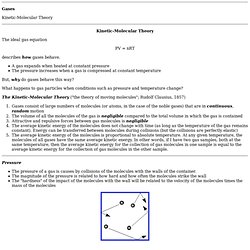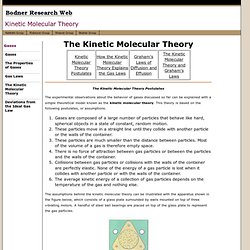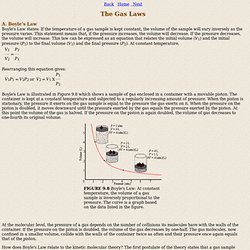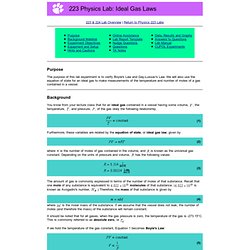

Apologia, ed. 1, Module 2 Concept Map - What is covered in Module 2? Kinetic Molecular Theory. Gases Kinetic-Molecular Theory The ideal gas equation PV = nRT describes how gases behave.

A gas expands when heated at constant pressure The pressure increases when a gas is compressed at constant temperature But, why do gases behave this way? What happens to gas particles when conditions such as pressure and temperature change? The Kinetic-Molecular Theory ("the theory of moving molecules"; Rudolf Clausius, 1857) Gases consist of large numbers of molecules (or atoms, in the case of the noble gases) that are in continuous, random motion The volume of all the molecules of the gas is negligible compared to the total volume in which the gas is contained Attractive and repulsive forces between gas molecules is negligible The average kinetic energy of the molecules does not change with time (as long as the temperature of the gas remains constant).
Pressure The pressure of a gas is causes by collisions of the molecules with the walls of the container. Absolute Temperature Molecular Speed Example: Kinetic Molecular Theory. The Kinetic Molecular Theory The Kinetic Molecular Theory Postulates The experimental observations about the behavior of gases discussed so far can be explained with a simple theoretical model known as the kinetic molecular theory.

This theory is based on the following postulates, or assumptions. Gases are composed of a large number of particles that behave like hard, spherical objects in a state of constant, random motion. These particles move in a straight line until they collide with another particle or the walls of the container. The assumptions behind the kinetic molecular theory can be illustrated with the apparatus shown in the figure below, which consists of a glass plate surrounded by walls mounted on top of three vibrating motors.
When the motors are turned on, the glass plate vibrates, which makes the ball bearings move in a constant, random fashion (postulate 1). KE = 1/2 mv2. Tx95. The Gas Laws A.

Boyle's Law Boyle's Law states: If the temperature of a gas sample is kept constant, the volume of the sample will vary inversely as the pressure varies. This statement means that, if the pressure increases, the volume will decrease. Gas Properties - Gas, Pressure, Volume. Topics Ideal Gas Law Kinetic Molecular Theory Diffusion PV Work Maxwell-Boltzmann Distribution Description Pump gas molecules to a box and see what happens as you change the volume, add or remove heat, and more.

Measure the temperature and pressure, and discover how the properties of the gas vary in relation to each other. Gas Law Labs. 223 Physics Lab: Ideal Gas Laws. 223 & 224 Lab Overview | Return to Physics 223 Labs Purpose The purpose of this lab experiment is to verify Boyle's Law and Gay-Lussac's Law.

We will also use the equation of state for an ideal gas to make measurements of the temperature and number of moles of a gas contained in a vessel. Background You know from your lecture class that for an ideal gas contained in a vessel having some volume, , the temperature, , and pressure, Gas Laws lab. Gas Laws. Gas Laws Boyle's Law Torricelli's experiment did more than just show that air has weight; it also provided a way of creating a vacuum because the space above the column of mercury at the top of a barometer is almost completely empty.

(It is free of air or other gases except a negligible amount of mercury vapor.) Torricelli's work with a vacuum soon caught the eye of the British scientist Robert Boyle. Boyle's most famous experiments with gases dealt with what he called the "spring of air. " Boyle studied what happened to the volume of the gas in the sealed end of the tube as he added mercury to the open end. Boyle noticed that the product of the pressure times the volume for any measurement in this table was equal to the product of the pressure times the volume for any other measurement, within experimental error.
This expression, or its equivalent, is now known as Boyle's Law. Amonton's Law The following data were obtained with this apparatus. TK = ToC + 273.15 Charles' Law Gay-Lussac's Law n.